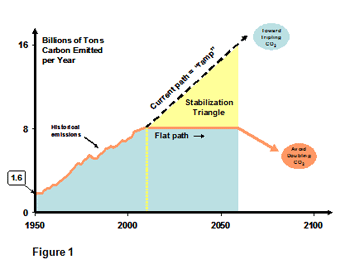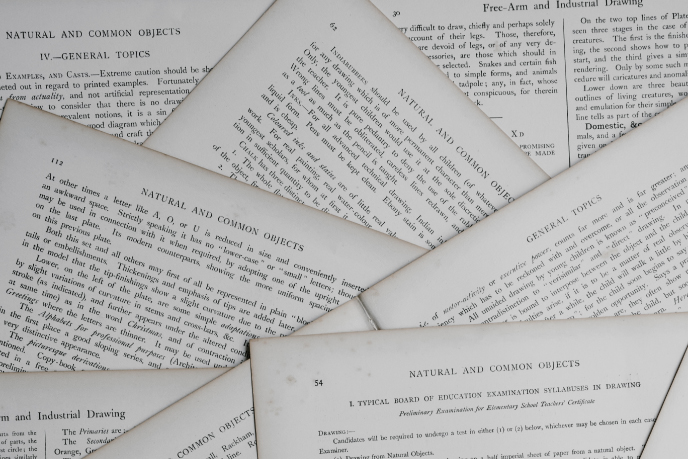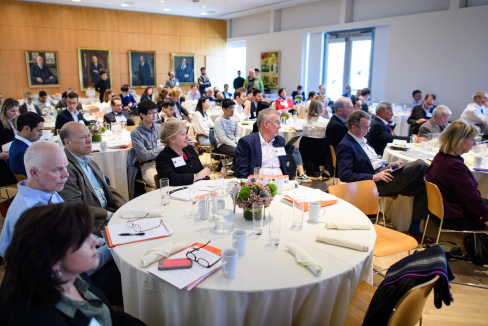Building the Stabilization Triangle
We already have the technology we need to take the world off the path toward dramatic climate change.
 Carbon emissions from fossil fuel burning are projected to double in the next 50 years (Figure 1), keeping the world on course to more than triple the atmosphere’s carbon dioxide (CO2) concentration from its pre-industrial level. This path (black line) is predicted to lead to significant global warming by the end of this century, along with decreased crop yields, increased threats to human health, and more frequent extreme weather events.
Carbon emissions from fossil fuel burning are projected to double in the next 50 years (Figure 1), keeping the world on course to more than triple the atmosphere’s carbon dioxide (CO2) concentration from its pre-industrial level. This path (black line) is predicted to lead to significant global warming by the end of this century, along with decreased crop yields, increased threats to human health, and more frequent extreme weather events.
In contrast, if emissions can be kept flat over the next 50 years (orange line), we can steer a safer course. The flat path, followed by emissions reductions later in the century, is predicted to limit CO2 rise to less than a doubling and skirt the worst predicted consequences of climate change.
Keeping emissions flat for 50 years will require trimming projected carbon output by roughly 8 billion tons per year by 2060, keeping a total of 200 billion tons of carbon from entering the atmosphere (yellow triangle). We refer to this carbon savings as the stabilization triangle.
 To keep pace with global energy needs at the same time, the world must find energy technologies that emit little to no carbon, plus develop the capacity for carbon storage. Many strategies available today can be scaled up to reduce emissions by at least 1 billion tons of carbon per year by 2060. We call this reduction a wedge of the triangle (Figure 2). By embarking on several of these wedge strategies now, the world can take a big bite out of the carbon problem instead of passing the whole job on to future generations.
To keep pace with global energy needs at the same time, the world must find energy technologies that emit little to no carbon, plus develop the capacity for carbon storage. Many strategies available today can be scaled up to reduce emissions by at least 1 billion tons of carbon per year by 2060. We call this reduction a wedge of the triangle (Figure 2). By embarking on several of these wedge strategies now, the world can take a big bite out of the carbon problem instead of passing the whole job on to future generations.
We Have the Technology
Each of the 15 strategies below has the potential to reduce global carbon emissions by at least 1 billion tons per year by 2060, or 1 wedge. A combination of strategies will be needed to build the eight wedges of the stabilization triangle.
EFFICIENCY
 Double fuel efficiency of 2 billion cars from 30 to 60 mpg.
Double fuel efficiency of 2 billion cars from 30 to 60 mpg.- Decrease the number of car miles traveled by half.
- Use best efficiency practices in all residential and commercial buildings.
- Produce current coal-based electricity with twice todays efficiency.
FUEL SWITCHING
 Replace 1400 coal electric plants with natural gas-powered facilities.
Replace 1400 coal electric plants with natural gas-powered facilities.
CARBON CAPTURE AND STORAGE
 Capture AND store emissions from 800 coal electric plants.
Capture AND store emissions from 800 coal electric plants.- Produce hydrogen from coal at six times today’s rate AND store the captured CO2.
- Capture carbon from 180 coal-to-synfuels plants AND store the CO2.
NUCLEAR
 Add double the current global nuclear capacity to replace coal-based electricity.
Add double the current global nuclear capacity to replace coal-based electricity.
WIND
 Increase wind electricity capacity by 10 times relative to today, for a total of 2 million large windmills.
Increase wind electricity capacity by 10 times relative to today, for a total of 2 million large windmills.
SOLAR
 Install 100 times the current capacity of solar electricity.
Install 100 times the current capacity of solar electricity.- Use 40,000 square kilometers of solar panels (or 4 million windmills) to produce hydrogen for fuel cell cars.
BIOMASS FUELS
 Increase ethanol production 12 times by creating biomass plantations with area equal to 1/6th of world cropland.
Increase ethanol production 12 times by creating biomass plantations with area equal to 1/6th of world cropland.
NATURAL SINKS
 Eliminate tropical deforestation.
Eliminate tropical deforestation.- Adopt conservation tillage in all agricultural soils worldwide.
No one strategy will suffice to build the entire stabilization triangle.
New strategies will be needed to address both fuel and electricity needs, and some wedge strategies compete with others to replace emissions from the same source. Still, there is a more than adequate portfolio of tools already available to build the stabilization triangle and control carbon emissions for the next 50 years.



